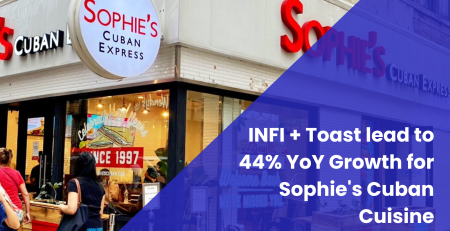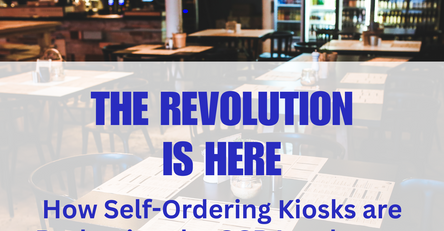9 Ways To Conquer the Restaurant Worker Shortage


A national labor shortage impacting the service industry is still in full force. Restaurants of all sizes are having trouble keeping employees and finding new ones. Many have cited high unemployment benefits amid the coronavirus pandemic as the cause, but the truth is much more complicated and nuanced. In this article, we’ll cover what really caused the restaurant industry to see a nosedive in labor, the impact it had on restaurants, and what you can do as a restaurant operator to overcome it.
What Caused the Restaurant Industry To Have a Worker Shortage?
As mentioned above, COVID-19 played a large role in many people leaving restaurant jobs. As of 2021, the labor shortage in the food service industry is tied to a myriad of reasons, from folks who were forced to leave their restaurant job early in the pandemic and then created a career in a different industry, to people who simply crunched their finances and could find work elsewhere that was less strenuous and paid higher wages.
In fact, 15% of hourly workers said they have changed industries in the past year, while 33% said they would like to do so, according to a Technomic study. Even more, 30% of former restaurant employees found more traditional career-oriented jobs like office jobs (30%) and teaching or education (17%).
The reasons people are leaving the service industry are just as diverse as the workers themselves. Therefore, simply blaming the shortage on unemployment benefits is not an accurate or valid representation of what’s truly happening.
The Impact of a Worker Shortage on Restaurants
1) Closings & Reduced Hours of Operation
Perhaps the most obvious sign of labor shortages across the country is the reduced hours and closures of restaurants. This is happening as more employees leave and restaurants generally don’t have enough staff to stay open and operational.
2) Longer Wait Times
When restaurants hit hard by labor shortages are open, there are often longer wait times for customers. The less staff a restaurant has, the fewer people there are to run the business, from cooking and cleaning to front-of-house staff. Longer wait times can lead to a worse experience for the customer and may even result in less frequent visits.
3) Decreasing Profit Margins
Combining the previous two points, with fewer staff members and a restaurant moving at a slower pace, profit margins will most likely decrease, thus, tightening finances in an already difficult time.
4) Higher Restaurant Staff Turnover
Though it’s difficult for restaurant owners and operators to find staff right now, the staff that is on payroll is turning over faster than pre-labor shortage. This often is because staff members find better or higher paying jobs elsewhere.
Tips for Battling the Labor Shortage & Helping Your Restaurant Survive (and Thrive)
This all may sound extremely bleak, but luckily, there are some tips and tricks you can implement within your business to survive the worker shortage.
1) Consider Self-Ordering Kiosks
The addition of self-ordering kiosks in restaurants has been growing in popularity since before the pandemic, so if you’re able, invest in one or two to keep your business moving. Though self-ordering kiosks can’t (and shouldn’t) replace all of your staff members, they could provide much-needed relief to the staff members you still have as well as a relief to your bottom line.
Additionally, the majority of customers are comfortable with self-ordering kiosks — many even prefer it over ordering from a cashier. “More than 65% of customers said they would be more willing to visit a restaurant if self-service kiosks were offered,” according to a survey by Tillster. “The survey also found that if the cashier line reaches four people, customers prefer to order from the kiosks instead. In addition, even if line lengths are equal, 30% of customers will opt for the kiosk.”
If you’re interested in learning more about self-ordering kiosks, check out INFI’s restaurant self-ordering total solution.
Want to learn why self-ordering kiosks can be important for QSR restaurants? Check out our article on the importance of getting a self-ordering kiosks.
2) Focus on Staff Retention
Retention of staff is another huge concern in the midst of the national labor shortage because keeping current staff is always less expensive than finding, hiring, and training new staff. According to the Bureau of Labor Statistics, the turnover rate for the hospitality industry reached 130.7% in 2020, compared to 78.9% in 2019.
There are many ways you can effectively retain staff, such as paying livable wages, providing affordable access to health care through insurance, offering training and growth opportunities, and ensuring your vetting process is thorough.
One quick-service restaurant, Sprockets, is joining the many restaurants now using a self-serve hiring tool “that blends artificial intelligence, machine learning, and psychological research,” according to QSR Magazine. To ensure the restaurant is vetting the best applicants for the job with the proper skills and drive to learn, the company sends out a brief survey to all applicants. The survey gauges applicants — based on data from the company’s top-performing employees — and can determine which applicants will perform best.
Using this tool, Sprockets has seen an increase in a restaurant’s 90-day retention rate by as much as 43%. “And, because this restaurant is able to keep more employees, the turnover rate continues to drop, since there are fewer holes to fill in each 90-day cycle,” QSR reports.
Interested in making your restaurant more tech-savvy? Learn more here.
3) Raise Awareness of Your Job Openings
Another strategy you can use to combat the worker shortage is to boost awareness that your restaurant is hiring. This goes beyond posting advertising at your location and in local news sources. One way to do this is by creating an employee referral program. To do this, you can create incentives for staff to bring in qualified friends, family, or anyone in their network who is looking for work. Rewards could include a cash bonus for each hired and retained staff member or a paid day off work.
Another way to spread the word about open positions is by utilizing social media. If your restaurant has a presence on social media, use this to your advantage. Even if you don’t have a dedicated page for your business, post on your social networks and ask your network to share your post.
A third way to bring awareness to your job opening is to host a networking event for the hospitality industry in your area. You don’t necessarily need to market the event as a job fair, but hosting an industry trivia night could mean an opportunity to talk to qualified folks who may be in the market for a new gig.
4) Enhance Your Restaurant’s Culture
Once you’ve done the heavy lifting of promoting open positions, you’ll want to be sure your business is appealing to applicants. In addition to solid pay and benefits, the culture of your restaurant should be friendly, fun, and respectful. Here are some ways you can foster a strong culture in your restaurant:
- Put an emphasis on ethics and values: This includes things like respect, trustworthiness, accountability, cooperation, and morality. This also means leading by example.
- Ensure your vision and mission statements are updated: Your company’s mission and vision should directly reflect your values and is an easy way for any new employee to get a snapshot of what you really care about.
- Create positivity around scheduling: Schedules and changing schedules are often the cause for inter-employee conflicts, so make sure you have a solid scheduling platform and process that everyone understands and abides by.
- Celebrate each other: Plan events or outings with your staff to drive home your business’s mission and vision. Events that are outside of work hours can also give co-workers a chance to get to know each other and create deeper bonds.
5) Rework Your Staff Compensation Model
Before re-evaluating how much you’re paying team members at your restaurant, you’ll want to ensure your compensation model is up to snuff. For most restaurants, there are a few different compensation models based on role within the business. Typically, cashiers, line cooks, dishwashers, hosts, and part-time, back-of-house workers are paid hourly, while management roles are paid a salary.
A third category that some restaurants may have is wait staff. Most models are still based on a low hourly wage with take-home tips accounting for the difference. However, there is a growing trend of restaurants changing how their wait staff is compensated to ensure they can still make proper wages without relying so heavily on tips. This is mostly seen in metropolitan areas like New York, Los Angeles, and Chicago.
At these restaurants, there may be an automatic 20% that customers pay on top of their meal that is then used to pay each wait staff member a fair, livable wage. In these cases, customers are not expected to leave a tip on top of the 20% service fee.
When it comes to management roles, according to BDO, 75-90% of total pay for management positions typically comes from a base salary. The rest may be variable pay such as performance-based bonuses on an annual basis or long-term compensation incentives.
6) Offer a Benefits Package
In addition to cash earnings, your business can stand out by offering additional benefits such as health insurance, profit sharing, on-the-job training opportunities, and flexible schedules.
We have started seeing businesses around the country adding enticing benefits that had previously been unheard of. For example, retailers like Target and Walmart stay closed on Thanksgiving so employees can be home with their families. Best Buy has even started offering backup childcare to its employees through Care.com, according to CNBC. The retailer also began to provide $100 per month in reimbursements for tutors for children between ages five and 18, as well as expanding its paid leave program up to six weeks.
7) Ensure Health and Safety on the Job
Everyone wants to work for a business that is safe and takes health seriously. This is especially true during a pandemic. It was revealed during a survey of small business employees that employers often undersell their workplace safety record. “Along with compensation and commute length, workplace safety is one of the top criteria small business employees consider when they evaluate a new job,” QSR Magazine reports. However, “nearly one in five respondents of the survey said they never received workplace safety training and 40% said their employer does not post the required Occupational Safety and Health Administration (OSHA) signage prominently.”
Here are some ways you can ensure the health of your employees and boost your reputation of being a safe place to work:
- Provide safety training upon hiring and annually
- Remind employees of health and safety expectations year round
- Recognize risks of the jobs and identify potential hazards
- Take your employees’ health seriously (this includes encouraging employees to stay home if they’re sick)
8) Increase Wages
Compensation is the starting point for most job seekers. Everyone needs to earn money to support themselves and their families, and low wages can make that nearly impossible. So another way to add appeal to your restaurant would be to rethink your wages.
Check out how some fast food businesses have changed up their models amidst the worker shortage, according to CNBC:
- McDonald’s is working on raising their wages. Varying by location, entry level team members will make from $11 to $17 per hour, and shift managers will make $15 to $20 per hour.
- Chipotle boosted its workers’ pay for an average of $15 per hour, ranging from $11 to $18. They also introduced a referral bonus of $200 for crew members and $750 for apprentices or management.
9) Make Job Listings Appealing to the Younger Workforce
A large portion of workers in the restaurant industry are younger; therefore, in order to reach them, you’ll want to make your job listings appealing to the younger workforce. Some ways you can do this include:
- Clearly state that you hire entry-level candidates and provide paid job training
- Post where young people are, like on social media, at local colleges and high schools, and in places young people hang out in your community
- Use creative video in your digital ads to stand out among other job postings
- Highlight company culture and any unique perks, such as tuition reimbursement and paid time off
Looking to understand how much labor cost is eating into your revenue? Check out our guide on how to calculate labor cost percentage.
When Will the Restaurant Worker Shortage End?
With all of these points in mind, you may be wondering, “When will this all end?” Unfortunately, it may be a while until we start to see the labor market truly bounce back to pre-pandemic levels.
The January 2022 jobs report showed a slowdown in job creation, and the February 2022 report showed a higher number of unemployed people. These numbers are mainly due to the Omicron variant; nearly nine million people missed work due to illness in January 2022, according to Bloomberg.
Because of this all, we can’t say for certain when exactly the labor shortage will end, but based on what we’ve seen already in 2022 when it comes to job numbers, the pandemic will continue to have the largest impact on the labor shortage.
INFI Is Here to Help You Battle the Restaurant Labor Shortage
Now that you have several areas to explore to help your restaurant tackle the worker shortage head-on, we encourage you to take a closer look at how self-ordering kiosks could help your business thrive during these difficult times. Learn more about INFI and self-ordering kiosks.
About infikiosk
Related Posts

Case Study: Sophie’s Cuban Cuisine Drives Revenue Growth with Advanced Self-Order Kiosk Technology
Client: Sophie’s Cuban Cuisine Industry: Fast Casual Dining Locations: 11 Point of Sale: Toast Key Stakeholder: George J. Cestero, COO & IT/Digital Marketing Director...
6 QSR Trends That Are Changing the Restaurant Industry
Today, QSR establishments continue to see ongoing changes in response to social and technological developments. We’ve compiled six of the...
The Revolution is Here: How Self-Ordering Kiosks are Reshaping the QSR Landscape
One particular innovation has started to significantly reshape the QSR industry landscape—self-ordering kiosks.
Maximizing Efficiency During Restaurant Slow Periods: A Digital Approach
This blog post explores how to navigate these slow periods effectively, focusing on digital investments and smart strategies to enhance...
Navigating the Future of QSRs: The Role of Kiosks and Technology
We went through these articles and skimmed through the almost 500 comments to get some insight on how people are...
How to Open a Pizza Place: Step-by-Step Guide & Tips
If you’re considering starting a pizza place, follow this comprehensive guide to ensure your success.
Comparing Self-Ordering Kiosks vs. Traditional Counter Service: Which Is Right for Your Restaurant?
This article delves into the pros and cons of self-ordering kiosks versus traditional counter service to help you determine which...
Top Marketing Ideas for Quick Service Restaurants (QSRs)
QSRs need to leverage creative approaches to boost brand visibility and drive sales. Here are some top marketing ideas...
The True Costs of Online Ordering: DIY vs. Third-Party Platforms
As online ordering continues to reshape the restaurant industry, businesses face a crucial decision: build an in-house ordering system or...





